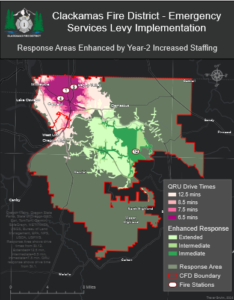About The Levy
Clackamas Fire is one of the largest and busiest fire agencies in the region, serving 220,000 residents across 235 square miles. Demands for emergency response are growing, with more than 30,000 annual calls. Since 2021, there has been a 15% increase in call volume yet budget
constraints resulted in a 9% decrease in emergency staffing. With wildfire risk is also increasing, the permanent tax rate needed to be able to keep up with the community’s demand.
An open letter from Clackamas Fire District Chief Nick Browne:
Dear Community Member,
Subject: Year 2 Emergency Services Levy Implementation
I am thrilled to share that with the opening of Station 13 scheduled for July 1, 2024; we have successfully met all the objectives of our Year 1 Emergency Services Levy implementation plan. This milestone includes increased staffing at the following locations and communities affected by the increased staffing:
- Station 1 (Unincorporated Clackamas County, Happy Valley, Milwaukie)
- Station 8 (Clackamas, Happy Valley, Damascus)
- Station 13 (Clarkes, Beavercreek), will be staffed 24 hours a day, 7 days a week
- Station 14 (Boring, Eagle Creek)
- Station 15 (Oregon City, Oak Lodge, Clackamas)
- Station 16 (Oregon City, Beavercreek)
- Station 19 (Damascus, Happy Valley, Boring)
Our priorities for staffing and deployment increases funded by the levy are based on community input and our Data Analytics. To ensure our decision-making process is backed by quantifiable data, we have implemented Darkhorse Emergency, a premiere analytics provider. Our metrics for determining staffing increases are based on the following areas:
- Promise to the Community
- Wall-to-Wall Service Level Increase Approach of Coverage for All Communities
- NFPA 1720, Call Volume, and Unit Utilization
- Annual Structure Fires per Planning Zone over the Last Four Years
- Addresses Without a Fire Hydrant
- Firefighter Safety
- Heavy Asset Impacts/Availability
- Wildfire Protection
- Response Time
Now, we are excited to share our Year 2 Levy Implementation Plan. Effective January 1, 2025, we will be staffing a Paramedic Quick Response Unit (QRU) staffed with two firefighters staffed at Station 1. This initiative aims to positively impact and reduce call volume for the following stations and increase service levels and effective response forces for life-saving emergencies in the following communities:
- Station 1 (Unincorporated Clackamas County, Happy Valley, Milwaukie)
- Station 4 (Milwaukie, Unincorporated Clackamas County)
- Station 5 (Happy Valley, Unincorporated Clackamas County)
Additionally, by the summer of 2025, Station 12 (Logan, Redland, Eagle Creek) will be staffed 24/7 to enhance its emergency response capabilities and the effective response force for life-saving emergencies for the communities of Logan, Redland, and Eagle Creek.
The Year 2 Levy Plan represents our unwavering dedication to the safety and well-being of our community. We are confident that this strategic approach, coupled with the incorporation of reliable data and advanced analytics, is creating a more efficient, effective, and responsive emergency services system.
As we continue to move forward with our Emergency Services Levy implementation, we encourage your engagement as we move towards the full implementation of the Year 2 Levy Plan. Together, we can build a safer and more secure environment for our community.
Sincerely,

Chief Nick Browne
Clackamas Fire District
Maps
Archived Letters
In The News
May 18, 2023, Milwaukie Review, Clackamas Fire officials thank voters for passing tax levy
May 17, 2023, KOIN, Clackamas Fire District levy passage looks likely with preliminary election results
May 16, 2023, Milwaukie Review, Voters give an extra $14.5 million annually for Clackamas Fire
May 15, 2023, KOIN, Clackamas voters to decide on fire district’s first-ever levy
January 24, 2023, The Outlook, Clackamas Fire District Board green lights emergency safety levy
January 12, 2023, Milwaukie Review, Clackamas Fire Board to ask voters for tax increase to hire firefighters
January 5, 2023, KOIN, Staffing challenges, funding concerns force Clackamas Fire to enact levy proposal
FAQs
Why does our community need an emergency services levy?
Clackamas Fire crews are
understaffed. National best practices for safety and effective response
call for increased staffing on each fire apparatus.
This disparity raises concerns about safe and effective response, especially during high-volume periods and wildfire season. Clackamas Fire leadership has dedicated emergency services levy funds to meet national best practices.
Prior to levy passage, Clackamas Fire was unable to commit full-time staffing for Logan and Clarkes Community Fire Stations. These stations were designed to provide emergency response to a large, rural service area and are critical to wildfire protection. Levy funds will now allow the district to offer 24/7 staffing at these stations, which will significantly enhance emergency response effectiveness across a wide territory, and place firefighters and equipment closer to areas with significant wildfire risk.
What does the levy fund?
The emergency services levy will ultimately fund 62 full-time positions, supporting safe, effective, and best practice staffing models across the district while also meeting the increased demands of wildfire response.
Clackamas Fire established an initial set of staffing and operational priorities funded through the levy, including:
- Hiring additional firefighters to provide four-person staffing in most stations,
- Full-time staffing of rural fire stations (Logan and Clarkes), and
- Implement an alternative response model which includes lighter resources to improve response efficiency in high-volume service areas.
- Funding for equipment critical to emergency and wildfire response.
How much will it cost?
The levy provides annual funding of $14.5 million. Levy rates are based on assessed property value, which is typically much less than a property’s real market value. The median homeowner in the Clackamas Fire District will pay between $119-138 annually.



